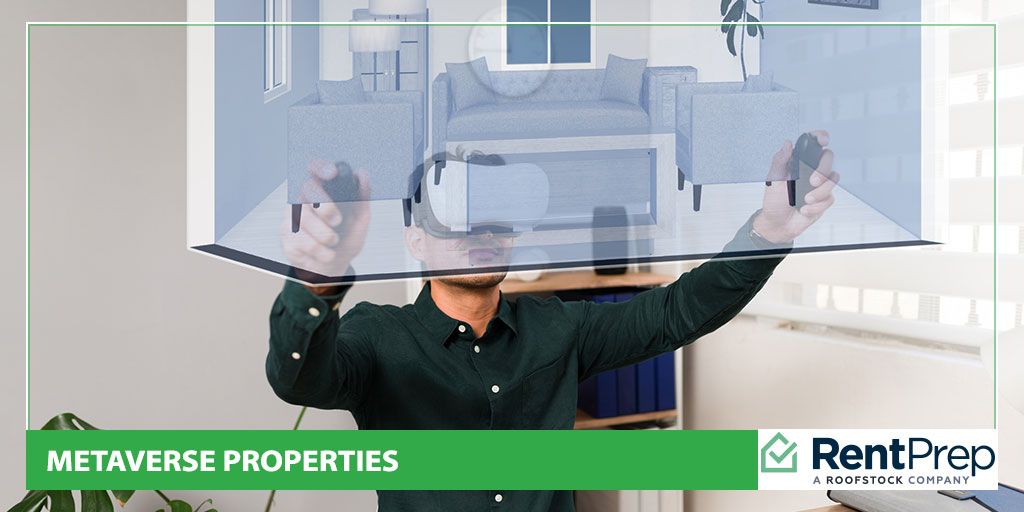
In 2021, Republic Realm purchased property in The Sandbox Metaverse with the intention of developing 100 island villas. On their first day of sales, they sold 90 of their islands for $15,000 each, and they are now reselling for over $100,000.
This is an incredible return on investment considering no one will ever set a real toe in these villas, since they only exist in the virtual world.
The Metaverse real estate market is booming. You can buy property in the metaverse for a fraction of the value of a similar property in the real world. You can then develop it without restriction and lease or sell just like you would real-world property. But how secure is this investment, since what you really own is a bunch of 1s and 0s?
We’ll introduce you to the realm of virtual real estate investment in the metaverse. We’ll explain exactly what the metaverse is, what a metaverse property is, and how exactly you buy and manage metaverse real estate. We’ll also look at the current value of metaverse land, what you can do with it, and the benefits and disadvantages of virtual property vs real-world property investment.
Finally, we’ll be asking the fundamental question: Is metaverse real estate currently a good investment?
Metaverse Property Table Of Contents
Learning more about metaverse property investment can open up a world of opportunities to create unique and potentially profitable virtual spaces.
- What Is The Metaverse?
- What Is Metaverse Property?
- How To Buy Metaverse Real Estate?
- How Much Are Metaverse Properties Worth?
- Metaverse Real Estate vs Real World Real Estate
- Can You Lease Metaverse Real Estate?
- Metaverse Property FAQs
- Investing In The Metaverse Market – Final Thoughts
What Is The Metaverse?

The metaverse is a collective virtual reality space in which people can interact in a computer-generated environment using virtual reality and augmented reality technologies.
Users create avatars to represent them in the virtual world, and via their avatar they can visit virtual environments, engage socially, participate in games and activities, and conduct business. Advocates of the metaverse describe it as a place where we can transcend physical limitations.
Currently, the metaverse is mainly used for immersive and interactive gaming experiences, virtual concerts, virtual workspaces for remote teams to collaborate, and the creation of virtual art. But use of the Metaverse is growing every day and it has significant potential for business and commerce, specifically digital marketplaces using virtual currencies, research and innovation, and also education and learning.
There is currently no single metaverse but rather a number of different companies creating virtual worlds that people can engage with. The most popular metaverses include:
- Decentraland: Founded in 2015 by Ari Meilich and Esteban Ordano in Argentina, it’s a community run environment mostly used for gaming.
- The SandBox: Founded by Arthur Madrid and Sebastian Borget in 2012 and acquired by Animoca in 2018, they have their own cryptocurrency called SAND.
- Roblox: This metaverse is home to over 20 million games all created by the community. Developers can make upwards of $1 million per year through in-game purchases.
- Fortnite: Epic Games, the game company behind Fortnite created this metaverse to support their entertainment world. Travis Scott recently gave a highly successful virtual event there.
- Second Life: This is one of the oldest virtual worlds where users can create avatars principally to socialize and engage in interactive activities.
- Facebook Horizon: Facebook has not yet opened their Metaverse, but it is expected to be a major game changer when it arrives.
What Is Metaverse Property?
Metaverse properties are virtual assets that exist within the metaverse, this includes virtual land and buildings but also other assets such as virtual works of art.
Focusing specifically on virtual land, the metaverse’s space is parceled into virtual properties that can be bought and owned. Ownership is managed using blockchain technology and non-fungible tokens (NFTs).
Metaverse land is treated like real-world property. For example, properties in The SandBox are parceled into standard squares of 106 by 106 feet, which also represents the pixel resolution of the property.
Just like physical property, users can buy, sell, and trade virtual land, and it can gain value based on factors such as location, size, scarcity, and demand. Land can be used to build or renovate virtual structures, create virtual businesses, and host events.
As an example, Travis Scott held a virtual concert in a virtual stadium within the metaverse, and the event is said to have generated $20 million in profit.
How To Buy Metaverse Real Estate?
Property purchases in the metaverse have real monetary value but are managed using cryptocurrencies, which use blockchain technology. This is because blockchain is also used to create the NFTs that record your ownership of the property.
Some metaverses, such as The SandBox, have their own dedicated virtual currencies that you can buy. Others use popular cryptocurrencies, such as Ethereum.
To exchange cryptocurrencies you need a digital wallet, and you will also need one capable of holding NFTs. The most popular options are Metamask and Binance.
You can buy virtual land directly from the metaverse in which it exists, and there are also third-party resellers for metaverse properties that work much like real-world real estate markets.
How Much Are Metaverse Properties Worth?

When the very first metaverse properties were sold back in 2017, you could get a standard parcel of land for about $20. By 2021, the price had reached $6,000, and by the start of 2022, $15,000.
As of June 2023, prices had dropped significantly to about $2,500 per parcel.
Just like in the real world, various factors can affect the value of a metaverse property, including location and how it has been developed. For example, someone spent $450,000 to be the virtual neighbor to Snoop Dogg in The Sandbox.
One investor bought a metaverse property for $10,000 and then partnered with Voxel Architects to digitally create a virtual mansion known as Meta Residence One in The SandBox. It is an 11,000-square-foot residence with seven bedrooms and nine bathrooms plus a walk-in wine cellar and infinity pool.
They have in turn partnered with Sotheby’s International Realty to match this virtual home with an identical real home located in a neighborhood not far from Miami. The pair, the virtual home and the real home, are now being sold together with a starting bid of $12.9 million. Interested parties can tour the real home or the virtual home.
It’s estimated that the current value of metaproperties across the major metaverses is around $1.4 billion and that there are 62,000 unique digital wallets that hold land.
Metaverse Real Estate vs Real World Real Estate
If you’re a property investor, you may be wondering how metaverse property compares with real-world property as an investment opportunity. There are a few benefits and disadvantages to consider.
Benefits Of Metaverse vs Real World Real Estate
Hot Investment
While metaverse real estate prices are a bit unstable, it’s currently a “hot” investment because you can get in on the ground floor of something that is bound to grow. For some people, original metaverse properties are like collector’s items, which only adds to their value over time.
No Limits
One of the characteristics of the metaverse is that it is a world without limits. There are no zoning concerns or planning permissions to seek. You can build what you want in the metaverse. So, yes, you can build your own personal skatepark or a three-story fountain.
Easy To Manage
Unlike real-world properties, metaverse properties are relatively easy to manage as you don’t need to worry about upkeep, seasonal pest control, or upgrading smoke detectors.
Accessible
The main benefit of the metaverse is that it is affordable. It makes ownership accessible for people who have always dreamed of owning their own property but aren’t financially able to break into the real-world market.
Disadvantages Of Metaverse vs Real World Real Estate
Volatile Market
If you bought metaverse property back in 2017, your investment has definitely paid off! But if you purchased it back in 2021 and didn’t do anything to develop your property, it is now worth about half what you paid for it.
This reflects the volatility of the market. Much like cryptocurrency, it is largely unknown, and it’s not linked to anything of tangible value such as gold. So, it’s literally worth whatever people will pay for it. This depends greatly on confidence in the technology, which in turn depends on how the metaverse evolves over the coming years.
While virtual reality is still quite niche, a lot of big tech companies are betting big on the future of the metaverse. Meta, previously Facebook, has drastically swung its investment portfolio toward the metaverse. Apple’s recent launch of the Vision Pro reflects a similar commitment to investing in the metaverse.
Infinite Availability
One of the reasons that metaverse property is currently so valuable is scarcity. There aren’t that many properties available in a market that people are becoming increasingly interested in. But while scarcity is currently a driving factor, it doesn’t really exist in the metaverse. There is no limit to how big the metaverse can grow and how many properties can be created.
Currently, different metaverses are putting caps on how many properties they release and leaving it to the community who already have property, to decide when to expand and create new properties. But these limitations are artificial and could be changed at any time.
Lack Of Regulation
The fact that the creators of the metaverse could change the rules about property ownership at any time points to the other big risk when it comes to metaverse property investment: the market is unregulated. There are no safety nets in place to protect your investment. Of course, that’s something else that could also change in the future.
Location Issues
While it is established that location matters when it comes to value in the metaverse, because the market is so new, it is unclear where the good locations are. For example, while The SandBox and Decentraland probably seem like good investments today because they are the most popular metaverses, what will happen when Meta releases Facebook Horizon? Will we see a mass migration to their metaverse?
Because there is no single virtual world or a single Metaverse property market, it is difficult to evaluate how properties will hold their value in future.
Read our guide to choosing the best locations for property investments here.
Can You Lease Metaverse Real Estate?
If you are considering buying to lease, this is just as common in the metaverse as in the real world. Many developers experimenting with metaverse creation prefer to lease properties rather than make the long-term investment in purchasing.
How exactly leasing is done depends on the specific metaverse. But you can expect leases of various durations for as little as a week to as long as a year. In most cases, the full lease must be paid for upfront in one of that metaverse’s preferred cryptocurrency of local tokens.
You will have a lease agreement that stipulates what the property can be used for and what condition it should be returned in.
Metaverse Property FAQs
Here are answers to some of the most frequently asked questions about metaverse properties:
Can I sell my metaverse property?
If you own a metaverse property, you can sell it on marketplaces that exist “in-game” within that specific metaverse or on secondary marketplace websites. You can list your property for a fixed price or open a timed auction.
Why is metaverse land so expensive?
Metaverse land is currently highly valued due to its scarcity. Property is limited and demand is growing quickly.
However, the scarcity of the market is artificial, as there is no limit on how big the metaverse can get. The creators have set limits in order to create value, but there is nothing technically stopping those limits from being expanded or lifted.
Is metaverse free to play?
Companies do not charge you to access the metaverse, but there is a significant upfront investment required to have the kit needed to interact within the metaverse. At a minimum, you need a powerful computer, headset, and controller, plus a fast internet connection. Increasingly, you will also need a virtual reality camera, headset, and sensors.
Most game spaces within the metaverse are free to enter, but there are “in-app” purchases available. For example, if you go to a meta golf course, you’ll need to rent the clubs, and if you go to a meta music venue, you’ll need to buy tickets.
Investing In The Metaverse Market – Final Thoughts
The big question is whether metaverse real estate is a good investment. This largely depends on your tolerance for risk. If you buy a metaverse property today and hold onto it, there is a good chance that it will drastically increase in value over the next five to 10 years as virtual reality becomes more mainstream.
But the risks are high because the structure of the mMetaverse is unclear. It’s uncertain how property will function when the metaverse becomes more highly developed and popular and how it will be regulated.
If you have the capital to gamble on risky investments that have the potential to yield a big pay off, the metaverse is an attractive prospect. But if you are looking for a secure investment, real-world property is still the best choice.
If you are considering breaking into the real work property market, read our guide to how to buy your first rental property.

